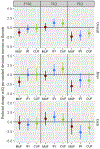Critical windows of fluoride neurotoxicity in Canadian children
- PMID: 34051202
- PMCID: PMC9884092
- DOI: 10.1016/j.envres.2021.111315
Critical windows of fluoride neurotoxicity in Canadian children
Erratum in
-
ADDENDUM: Critical windows of fluoride neurotoxicity in Canadian Children.Environ Res. 2022 Dec;215(Pt. 3):114468. doi: 10.1016/j.envres.2022.114468. Environ Res. 2022. PMID: 37310286 Free PMC article. No abstract available.
Abstract
Background: Fluoride has been associated with IQ deficits during early brain development, but the period in which children are most sensitive is unknown.
Objective: We assessed effects of fluoride on IQ scores across prenatal and postnatal exposure windows.
Methods: We used repeated exposures from 596 mother-child pairs in the Maternal-Infant Research on Environmental Chemicals pregnancy and birth cohort. Fluoride was measured in urine (mg/L) collected from women during pregnancy and in their children between 1.9 and 4.4 years; urinary fluoride was adjusted for specific gravity. We estimated infant fluoride exposure (mg/day) using water fluoride concentration and duration of formula-feeding over the first year of life. Intelligence was assessed at 3-4 years using the Wechsler Preschool and Primary Scale of Intelligence-III. We used generalized estimating equations to examine the associations between fluoride exposures and IQ, adjusting for covariates. We report results based on standardized exposures given their varying units of measurement.
Results: The association between fluoride and performance IQ (PIQ) significantly differed across prenatal, infancy, and childhood exposure windows collapsing across child sex (p = .001). The strongest association between fluoride and PIQ was during the prenatal window, B = -2.36, 95% CI: -3.63, -1.08; the association was also significant during infancy, B = -2.11, 95% CI: -3.45, -0.76, but weaker in childhood, B = -1.51, 95% CI: -2.90, -0.12. Within sex, the association between fluoride and PIQ significantly differed across the three exposure windows (boys: p = .01; girls: p = .01); among boys, the strongest association was during the prenatal window, B = -3.01, 95% CI: -4.60, -1.42, whereas among girls, the strongest association was during infancy, B = -2.71, 95% CI: -4.59, -0.83. Full-scale IQ estimates were weaker than PIQ estimates for every window. Fluoride was not significantly associated with Verbal IQ across any exposure window.
Conclusion: Associations between fluoride exposure and PIQ differed based on timing of exposure. The prenatal window may be critical for boys, whereas infancy may be a critical window for girls.
Keywords: community water fluoridation; critical windows of exposure; fluoride neurotoxicity; generalized estimating equations; intelligence quotient.
Copyright © 2021 The Author(s). Published by Elsevier Inc. All rights reserved.
Conflict of interest statement
Declaration of competing interest
The authors declare that they have no known competing financial interests or personal relationships that could have appeared to influence the work reported in this paper.
Figures


References
-
- Arbuckle TE, Fraser WD, Fisher M, Davis K, Liang CL, Lupien N, Bastien S, Velez MP, Von Dadelszen P, Hemmings DG, Wang J, Helewa M, Taback S, Sermer M, Foster W, Ross G, Fredette P, Smith G, Walker M, Shear R, Dodds L, Ettinger AS, Weber JP, D’Amour M, Legrand M, Kumarathasan P, Vincent R, Luo ZC, Platt RW, Mitchell G, Hidiroglou N, Cockell K, Villeneuve M, Rawn DFK, Dabeka R, Cao XL, Becalski A, Ratnayake N, Bondy G, Jin X, Wang Z, Tittlemier S, Julien P, Avard D, Weiler H, Leblanc A, Muckle G, Boivin M, Dionne G, Ayotte P, Lanphear B, Séguin JR, Saint-Amour D, Dewailly É, Monnier P, Koren G, Ouellet E, 2013. Cohort profile: the maternal-infant research on environmental chemicals research platform. Paediatr. Perinat. Epidemiol 27 (4), 415–425. 10.1111/ppe.12061. - DOI - PubMed
-
- Asbury K, Wachs TD, Plomin R, 2005. Environmental moderators of genetic influenceon verbal and nonverbal abilities in early childhood. Intelligence 33 (6), 643–661. 10.1016/j.intell.2005.03.008. - DOI
-
- Bǎran-Poesina V, Negreș S, Dobrescu D, Dimcevici-Poesina N, Dimcevici-Poesina A, Feghiu A, et al., 2013. Experimental pharmacological researches regarding the influence of sodium fluoride in allopathic and homeopathic doses on central nervous system’s performances. A correlation between behavioral response in classic maze test and morphological aspects of ce. Farmacia 61 (4). https://farmaciajournal.com/wp-content/uploads/2013-04-art.18.poesina-78..., 781–99.
Publication types
MeSH terms
Substances
Grants and funding
LinkOut - more resources
Full Text Sources
Other Literature Sources

